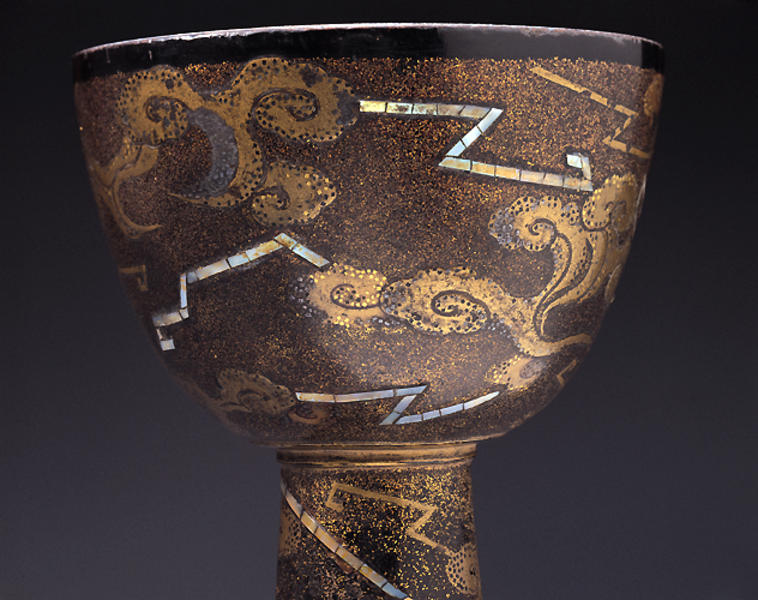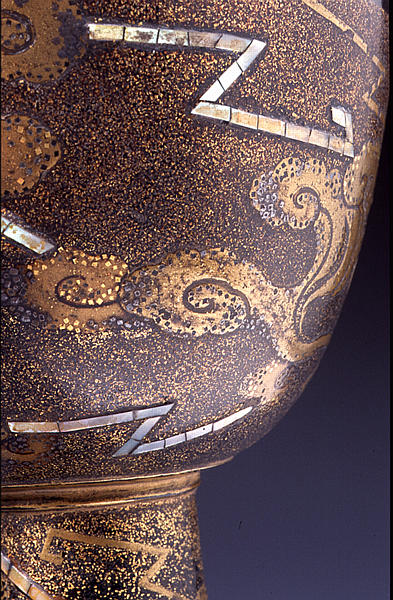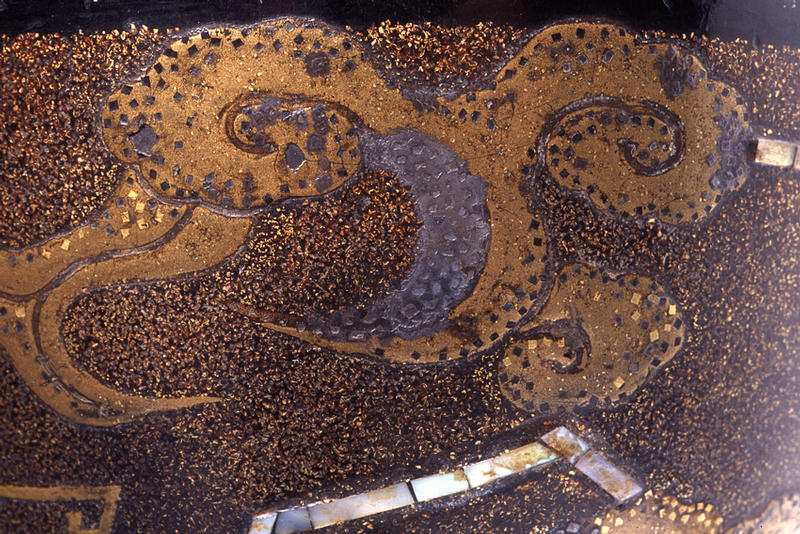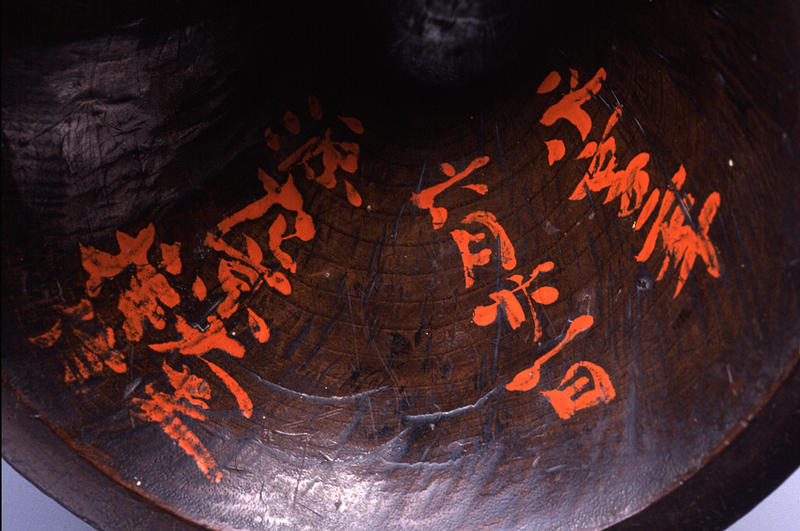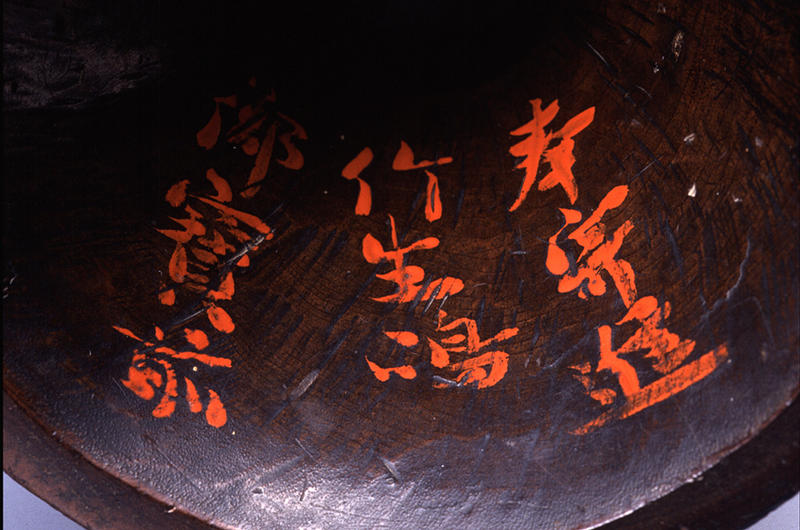雷雲蒔絵螺鈿鼓胴
- 室町時代
- 15c
- 螺鈿、金高蒔絵、切金
- H-27.5 D-13
- 所蔵
- 都久夫須麻(竹生島)神社奉納品、宝巌寺伝来
室町時代 15世紀
高:27.5cm 口径:12.5cm
電光を螺鈿,雲を金高蒔絵と切金で施した大鼓胴。
鼓胴には次の銘文がある。
「永享二年六月廿一日,源左京大夫持信奉寄進竹生嶋御宝前」。これにより,永享2年(1430)室町幕府六代将軍義教の側近,一色左京大夫持信が竹生島神社に奉納したことが知られる。
また,この鼓胴には織田信長の二通の書状が付属され,信長とこの鼓胴との関係を物語るものとしていっそうの歴史的な興味を感じさせる。
「青葉之笛持せ被越候 名物ニ候 前々誰之所持候て,何とある子細に依て竹生嶋へ寄進候哉 小笛添候 是も定子細可有之候 能々相尋候て,存知之躰を具書付候て,可被越候,恐々謹言
九月六日 信長(花押)
磯野丹波守殿」
織田信長から磯野員昌宛書状で,内容は,「竹生島の名物青葉の笛を見た。誰がどのような理由で竹生島に寄進したものか,また,これに添えられる小笛も由来があるようである。これらのことをつぶさに調査して知らせるように」というものである。
「青葉之笛到来候 是名物見事候 今少留置 遂一覧之,可令返進候,此笛当山へ寄付子細之随身候つる哉,小笛相添候,此由来等慥ニ存知之 (躰・を)□□書付(可被越)□□候,次静か所持候(由・之)□□小鼓筒之蒔絵ハ雷にて候由候,可被見候 猶磯野可申候 恐々謹言
九月六日 信長(朱印)
竹生嶋惣山中」
同じく信長から竹生嶋惣山中宛の朱印状で,内容は,「青葉の笛は到来した。まことに見事な名物である。しばらく手元において見たのち返す。この笛を当山へ寄進したのは誰で,その子細はどのようなことか,これに添う小笛の由来についても知りたい。また静所持という小鼓の胴は雷の蒔絵と聞く。ぜひ見たいものである。磯野に申しておくのでよろしく頼む」というものである。雷の蒔絵の小鼓とは本品であろう。(灰野)
参考文献「雷雲蒔絵鼓胴」灰野昭郎『学叢』5号 京都国立博物館 昭和58年
蒔絵
蒔絵
日本の漆工芸を代表する加飾法で我が国独自に発展した。漆で文様を描き、乾かないうちに金銀などの金属粉を蒔きつけて文様を表す。起源は奈良時代に遡り、正倉院の金銀でん荘唐大刀の鞘に施された末金るの技法と考えられる。
塩屋千鳥蒔絵硯箱
浄土図蒔絵小箱
梅月文螺鈿蒔絵文台
雲錦蒔絵提重 伝 春正作
袋物蒔絵大鼓胴
藤蒔絵長持
秋草蒔絵沈箱
菊鶴亀蒔絵硯箱
蒔絵手拭掛
蒔絵角盥
亀甲文蒔絵香合(鏡箱)
桐蒔絵硯箱
籬菊蒔絵香合(鏡箱)
枝垂桜蒔絵徳利
菊桐紋蒔絵盥
葡萄蒔絵水筒
桐巴紋枝垂桜蒔絵大棗
籬秋草桔梗紋散蒔絵厨子棚
Catalogue Entry
Muromachi period, 15th century
Height, 27.5cm; mouth diameter, 12.5cm
A large drum cylinder decorated with lightning bolts in mother-of-pearl and clouds created in gold takamakie and cut gold leaf.
The inscription on this drum body indicates that this drum was presented to the Chikubushima Shrine on the 21st day of the 6th month of 1430 (Eikyo 2) by Isshiki Sakyo-no-daibu Mochinobu, a close associate of Yoshinori, the 6th Muromachi shogun.
This drum cylinder is also accompanied by two letters written by Oda Nobunaga which explain the relationship between Nobunaga and this drum and further heighten the historical importance of the work.
In the letter written by Nobunaga to Isono Kazumasa, Nobunaga states that he has seen the famous "green leaf " flute of Chikubushima. He asks for a thorough study of the circumstances of the donation of this flute and its accompanying smaller flute to Chikubushima.
In a letter addressed to Yamanaka, who was the So of Chikubushima, and sealed with Nobunaga's red ink seal, Nobunaga states that the "green leaf" flute has arrived. Nobunaga comments on what a truly fine treasure it is. He states that he will keep it close at hand for awhile and then return it to Chikubushima. Then he asks for details on the donor of the flute to Chikubushima and the circumstances of its donation. Nobunaga mentions that he has heard of the small drum cylinder owned by Shizuka and decorated with a thunder motif makie. He states that he would definitely like to see this drum. Nobunaga ends the letter by stating that he would seek Isono's permission and thus hoped that Chikubushima would approve the viewing.
It is likely that the present drum cylinder is the small drum with thunder makie patterns mentioned in this letter. AH
Bibliography :
Haino Akio, "Raiun makie kodo," Gakuso Vol. 5, Kyoto National Museum, 1983.
かざり 図録解説
雷雲蒔絵螺鈿鼓胴 かざり 図録解説
雷光を螺鈿と高蒔絵、渦巻く雲を高蒔絵と截金(きりかね)で表した豪華な鼓胴で、白拍子(しらびょうし)であった静御前(しずかごぜん)が所用し、雨乞いの鼓として知られる「初音の鼓」の伝承をもつ。また、鼓の受にある朱漆の銘文より、永享二年(一四三〇)源左京大夫(みなもとのさきょうのだいふもちのぶ)持信(みなもとのさきょうのだいふもちのぶ)が琵琶湖の竹生島神社に奉納したことがわかる。
現在、この鼓胴には織田信長の書状二通が附属しており、その内容から信長が竹生島に寄進されていた「青葉の笛」を見たのちに、この鼓胴も見たことが読み取れる。本作は、蒔絵技法や寄進銘からみて、制作年代は静御前の生きていた時代までさかのぼらないが、天正年間には静所用としてその名が伝えられた名器であった。
木地は重く堅い淡墨桜で、鼓の内部には屋外用の遠音を出すことができる構造がみられ、内部の寸法にも薪能に使用された小鼓胴の特色がある。そのため加藤寛氏は、鼓胴の寸法は能楽の大鼓と一致するものの、この鼓は革を極限まで乾燥させて演奏する大鼓と違い、革に湿り気を与えて演奏する屋外用の小鼓胴として使用された可能性を指摘し、本作を能楽の小鼓胴の大きさが定まる以前の小鼓胴の一例として貴重な資料であると述べている。
KAZARI Catalogue Entries
Drum Cylinder with Thunder and Lightning KAZARI Catalogue Entries
Adorned with a pattern of lightning in mother-of-pearl and raised maki-e lacquer (takamaki-e), in addition to clouds in raised maki-e and cut gold (kirikane), this sumptuous hand drum is said to have been owned by the twelfth-century shirabyōshi dancer Shizuka Gozen. It is known by the name of “Hatsune no tsuzumi,” or “First Sound Drum.” An inscription in red lacquer inside the drum cavity indicates that the piece was given to Chikubushima Shrine at Lake Biwa by the courtier Isshiki Mochinobu (?-1434) in 1430 (Eikyo 2).
The drum is accompanied by two documents authored by Oda Nobunaga (1534-1582) that tell how the warlord saw the drum after seeing the famous flute named“Aoba” (Fresh Leaves), which had been donated to Chikubushima shrine. Although the maki-e technique and date of the inscription postdate the time of Shizuka Gozen, we learn how, during the Tensho era(1573-92), the piece was handed down as a relic of the legendary female dancer.
Made from hard and heavy cherry wood, the inside of the drum is constructed to produce distant-sounding tone, a feature of instruments used in outdoor performances. The dimensions of the piece’s interior reflect the characteristics of hand drums used in takigi no, outdoor noh performances held at night and illuminated by torchlight. On the basis of this correspondence in size, Kato Hiroshi has compared the drum with large drums (otsuzumi, or okawa) used in noh. He argued that, since the leather of otsuzumi needed to be completely dry during performances-a feature that differs in this work-the drum was likely used as a hand drum in outdoor performances and represents a rare example of hand drums prior to their standardization in size.

